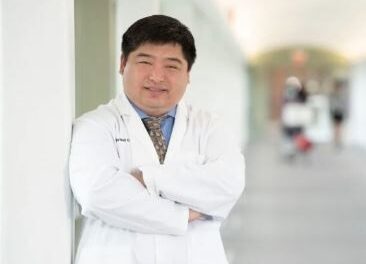 One of the more ambitious goals that Dr. Joseph Heyman set for himself as chair of the Board of Trustees for the American Medical Association (AMA)a post for which he was selected in June 2008is to see a universal coverage health system reform bill signed into law, with the AMA representing the interests of all patients and physicians.
One of the more ambitious goals that Dr. Joseph Heyman set for himself as chair of the Board of Trustees for the American Medical Association (AMA)a post for which he was selected in June 2008is to see a universal coverage health system reform bill signed into law, with the AMA representing the interests of all patients and physicians.
“I want to see a health plan that provides coverage to every person in the U.S. signed into law before my term as chair is over,” he says.
At the AMA, Dr. Heyman was part of the team that designed the AMA proposal for expanding health insurance coverage and choice, a key element of which is providing individuals and families with income-related subsidies for the purchase of insurance.
“I’m proud that during my term as chair, weve accomplished a lot, including overcoming a presidential veto and thereby protecting patients’ access to care by stopping cuts to Medicare reimbursements for physicians,” he says. “Health care reform is becoming increasingly important as costs continue to rise with 46 million people in the U.S. without health insurance.”
According to Dr. Heyman, AMA “Voice for the Uninsured” campaign began reaching out to voters and candidates during the early presidential primaries in Iowa, New Hampshire and South Carolina.
“Our goal was to raise awareness across the country that there were 46 million uninsured Americans, living sicker and dying younger,” he says. “During the final phase of the election, the ‘Voice for the Uninsured’ campaign has made great strides to urge candidates across the country to adopt AMA principles to cover the uninsured.”
Since the campaign’s launch, the AMA and its members have been in close contact with both political parties.
“We’ve been unequivocal in stressing the need to find a solution for the uninsured,” says Dr. Heyman. “We’re pleased that the parties have adopted many of the features of the AMA plan to cover America’s uninsured.”
Under the AMA plan, the vast majority of Americans would have the means to purchase health care coverage. The AMA plan gives individuals choices so they can select the appropriate coverage for themselves and their families. The plan also promotes market reforms in the insurance industry.
“The decision the AMA has made is to focus our efforts on a practical, workable solution that will reduce the number of the uninsured,” explains Dr. Heyman. “And we’re going to get there by building a grassroots network of patients and physicians, so that when 2009 comes, we’re moving forward with the force of patients’ and physicians’ voices from across the nation. We’re going to get there because we’ve laid the groundwork with policymakers throughout the country; with leading health policy experts of both parties; with the key players at the table.”
Dr. Heyman says that while the art and science of medicine is ever changing, the AMAs commitment to its mission is steadfast.
“We see a bright future for American medicine: greater emphasis on prevention, wider use of health information technology and a more efficient health care system,” he says. “The AMA and its quarter-million members will continue to be at the forefront when lawmakers search for practical solutions to the nation’s health care priorities. We’ll continue in that role and do our best to pave the way for establishing realistic solutions.”
Dr. Heyman’s leadership traits were firmly established by his previous work with the AMA. An obstetrician/gynecologist from Amesbury, Mass., Dr. Heyman has been a member of the AMA board since 2002. He served as AMA secretary from 2005 to 2006 and as chair of the finance committee.
“I appreciate the AMA because it leverages the talents of people of every political stripe,” says Dr. Heyman. “Members of the AMA of both political parties put the needs of patients first. My leadership has also been shaped by a career of physician and patient advocacy that has stretched over a quarter of a century. I’m passionate about getting things done.”
Another concern of Dr. Heyman’s is the physician shortage that the government predicts by 2020, where it’s expected that there will be a shortfall of about 85,000 physicians in many medical specialties. To help alleviate this, Dr. Heyman believes strongly that medical education reforms in the country are needed, including increasing medical school class sizes and allowing for additional residency slots to train physicians, specifically in needed specialties and regions.
“To improve the demographic distribution of physicians to underserved areas and undersupplied specialties we need to create incentives for those who choose to practice in areas of need,” he says. “To maintain a strong workforce, re-entry programs must address the educational needs of physicians returning to practice after clinical inactivity to ensure they are current and proficient in their practice area.”
Finally, to improve the attractiveness of careers in primary care, medical education and training will need to provide the key skills necessary for successful and satisfying medical careers, he adds. “The AMA supports partnerships between primary care physicians and patients to coordinate access to medical services and consultations and encourages physician reimbursement changes for those practicing primary care, for example, the medical home model.”
As he looks ahead to 2009 and beyond, Dr. Heyman says that some of the major trends and developments that will be shaping the medical profession is, and will continue to be, a greater focus on performance measurement.
“We need a single list of measures that are universal, are evidence based, and are shown to improve medical outcomes,” he says. “Additionally, genetics will play a huge role in the future of medicine with personalized medications, treatments and technology.”
Post Views: 756
 One of the more ambitious goals that Dr. Joseph Heyman set for himself as chair of the Board of Trustees for the American Medical Association (AMA)a post for which he was selected in June 2008is to see a universal coverage health system reform bill signed into law, with the AMA representing the interests of all patients and physicians.
One of the more ambitious goals that Dr. Joseph Heyman set for himself as chair of the Board of Trustees for the American Medical Association (AMA)a post for which he was selected in June 2008is to see a universal coverage health system reform bill signed into law, with the AMA representing the interests of all patients and physicians. 

























